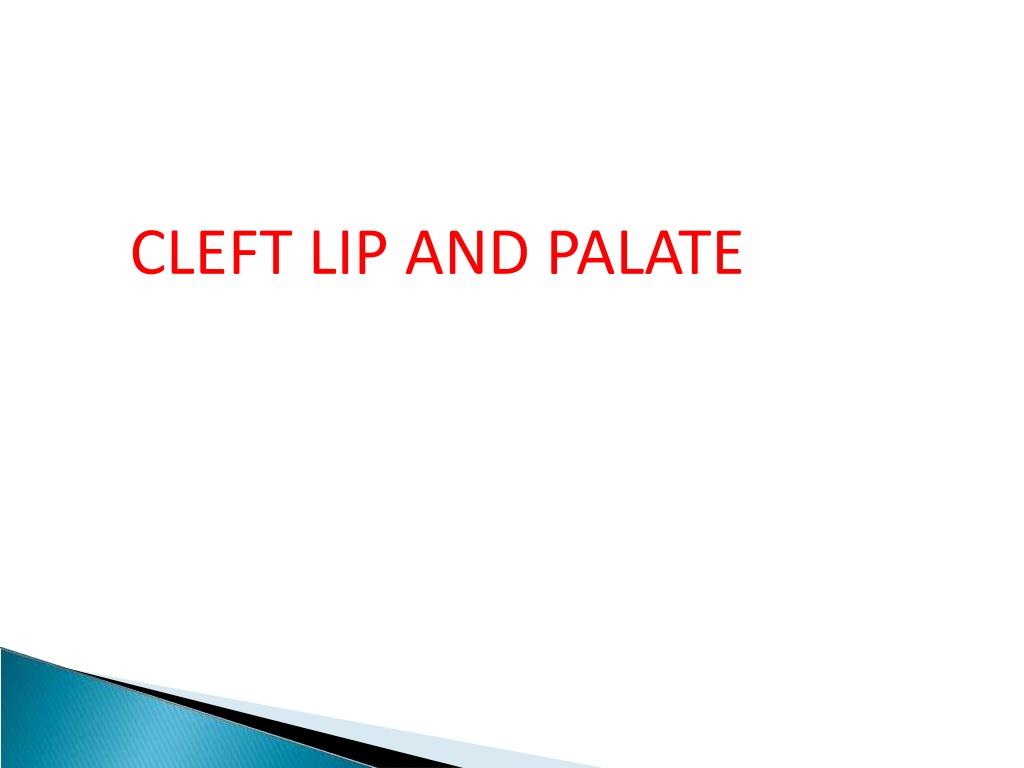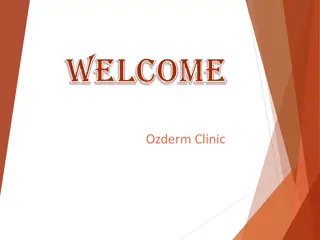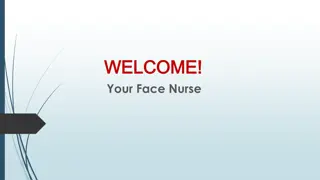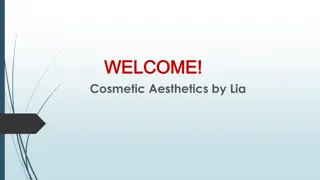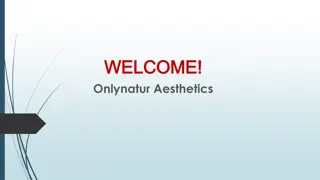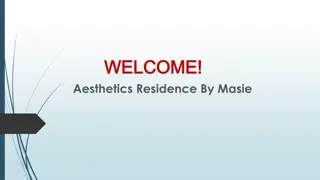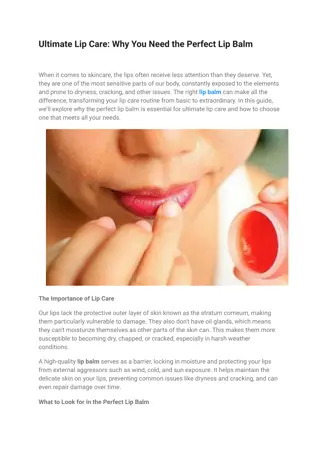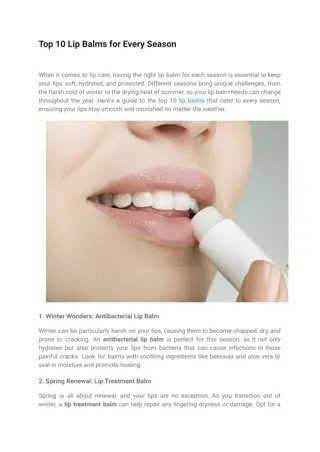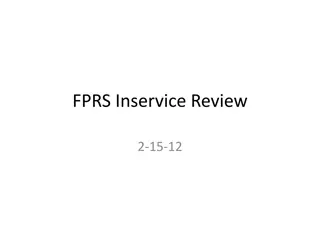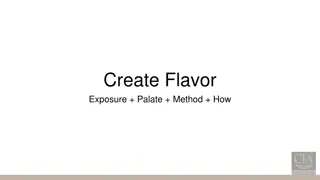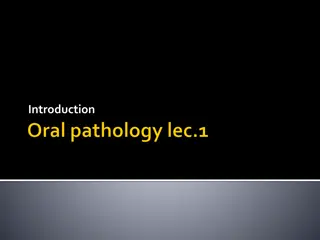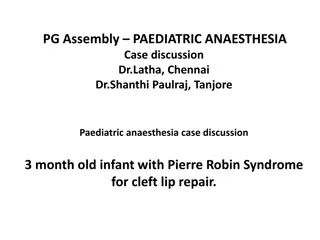CLEFT LIP AND PALATE
Management of cleft lip and palate involves treatment in different stages from birth to adulthood, including fabrication of obturators, surgical procedures, and postoperative care. The stages include passive obturator fabrication, presurgical orthopedics, and surgical management of cleft lip and palate. These interventions aim to improve feeding, speech, and overall oral health for individuals with cleft lip and palate conditions.
Download Presentation

Please find below an Image/Link to download the presentation.
The content on the website is provided AS IS for your information and personal use only. It may not be sold, licensed, or shared on other websites without obtaining consent from the author.If you encounter any issues during the download, it is possible that the publisher has removed the file from their server.
You are allowed to download the files provided on this website for personal or commercial use, subject to the condition that they are used lawfully. All files are the property of their respective owners.
The content on the website is provided AS IS for your information and personal use only. It may not be sold, licensed, or shared on other websites without obtaining consent from the author.
E N D
Presentation Transcript
Management of cleft lip and palate can be divided into following stages: Stage Stage I I- treatment done from birth to 18 month of age Stage dentition stage) Stage II II- - from 18 th month to 5th year of life( primary Stage stage from 6th to 11th year oflife Stage III III- - treatment carried out during mixed dentition Stage stage ( 12-18 years) Stage IV IV - treatment done during permanent dentition
Stage I treatment: Includes: i. Fabrication of a passive obturator ii. Presurgical orthopedics iii. Surgical management of cleft lip iv. Surgical management of cleft palate Passive Is an intraoral prosthetic device that fills the palatal clefts and provides false roofing against which child can suckle Reduces the feeding difficulties like insufficient suction, choking, excessive air intake Passive maxillary maxillary obturator obturator: :
Obturator is fabricated using cold cure acrylic after selective blocking of all the undesirable undercuts Clasp aid in retention, in case insufficient retention, wings made of thick wire can be imbedded in acrylic and made to follow cheek contour extraorally.
Where a=rotational flap b=advancement flap c=columella flap a and c are planned on medial side of Cleft.After full thickness Of lip is cut along the marking which is filled by b planned on lateral side In this method minimal Tissue is discarded and the Result can be modified during surgery.
Veau Veau repair repair
Surgical Should be attempted between 12-24 months of age. Facilitates normal speech, hearing and swallowing. Surgical palate palate closure closure:
The tension of lip closure centralises premaxilla and then the other side of lip is closed at 4 months of age. Vomerine flaps from right and left sides are used to close the anterior palate, which is done at 8-12 months using von langenback technique. Lip revision and columella lengthening are done at age of three years.
The Oslo protocol evolved at the Oslo Cleft Centre, which is one of the two centralized care centres in Norway. Their protocol does not follow preoperative orthopaedics. Millard s procedure is carried out for lip repair at the age of 3 months.
In cases with an associated cleft of the alveolus and palate, a cranial based single layer vomer flap is sutured under the alveolus palate periostium at the time of lip closure. In light of the present knowledge, ongoing research and different long-term and inter- centre studies, the Oslo protocol has been observed to generate good treatment outcome.
Remaining hard and soft palate closure is done at the age of 18 months by von Langenbeck pattern palatoplasty. Alveolar bone grafting is done at the age of 8-10 years.
Stage two treatment: Comprises treatment carried out during primary dentition period. Procedures carried out during this phase: Adjustment of intraoral obturator to accommodate the erupting deciduous teeth. To maintain a check on eruption pattern and timing. Oral hygiene instructions. Restoration of decayed teeth.
Orthodontic treatment is not normally recommended for primary dentition as it may damage permanent dentition follicles. However , in patients with: Moderately underdeveloped maxilla and no class III hereditary defect reverse headgear treatment should be advocated at age of 4 7 years.
Parents should understand the value of tooth brushing . Parents may be nervous to brush in region of cleft especially following primary lip and palate surgery. They should be shown in detail about how to brush. A low fluoride children toothpaste containing no more than 600 ppm fluoride is recommended for children under 6 years. Twice brushing daily is recommended. In addition, twice yearly professional application of topical fluoride varnish is useful.
Stage three treatment Carried out during mixed dentition phase. As in the early years, the main emphasis throughout the mixed dentition stage should be on prevention of dental disease. In this phase, secondary alveolar bone grafting is common.
A child with cleft palate may need surgery after intial cleft palate repair to replace missing bone in front of mouth and roof to the mouth. Successful grafting provides osseous envionment to permit spontaneous eruption of canine in grafted area and so should be undertaken after eruption of permanent incisors but before eruption of permanent canine. Alveolar bone grafting provides bony bridge to cleft in alveolar area.
Benefits of SABG: 1.Provides bony support for alar base to minimize nasal deformity. 2.Elimination of oronasal and nasolabial fistulae,hence avoiding nasal reflux of fluid and air.
3.Stabilization of maxillary segments,so as to facilitate future secondary corrective osteotomy if required. 4.Facilitation of teeth eruption into cleft site and achieve orthodontic movement adjacent to cleft site.
Timing of SABG: It is done at the age when growth inhibition effects of surgery are minimized and it can help maxillary canine and lateral incisor to erupt through the cancellous bone. It is done in mixed dentition stage after eruption of permanent incisors but before eruption of permanent canine.
Assessment for the need for bone graft Required careful clinical and radiological assessment Teeth in the vicinity of cleft area need to be assessed All retained deciduous teeth, supernumerary teeth and rudimentary teeth are usually extracted before bone graft
Pre bone graft orthodontics Maxillary arch expansion is performed preparatory to secondary bone grafting for which quad helix is appliance of choice. Nowadays repetitive weekly protocol of alternate rapid maxillary expansion and constriction are performed.
Clinical result of maxillary protraction using 2- hinged expander, repetitive weekly Protocol of Alt-RAM and intraoral protraction springs
Surgical technique Two surgeons work simultaneously, one on donor site and other on host site. It involves incision around margin of cleft alveolus Full thickness mucoperiosteal flap is raised to allow space for bone graft. Gingival mucoperiosteal is the most recommended one.
Iliac bone is harvested, packed in cleft alveolus space. the flap is then sutured to ensure complete seal. Post bone graft follow up requires retention of the expansion either by full bonded appliance or by reinserting a passive expansion appliance. some include surgical exposure of canine and orthodontic traction.
Orthodontic procedures carried out during mixed dentition phase are: 1. Correction of anterior crossbite using removable or fixed appliance can be used like Z springs 2. Buccal segment crossbites can be treated using quad helix and expansion screws which are pre bone graft orthodontics
Consist of treatment during permanent dentition. Presence of permanent dentition usually signs for the definitive orthodontic treatment. All local irregularities like crowding, spacing, crossbites and overjet overbite problems are corrected. Patients with hypoplastic maxilla may be given facemask to advance maxilla.
Regular oral hygiene monitoring and instruction is necessary. Dietary counselling. Patients are to be made aware of excessive sugar intake. Following orthodontic treatment procedures, the patients should on retention phase to maintain orthodontic correction
fig: Intraoral distraction device and segmental osteotomy for interdental distraction osteogenesis
Cleft lip Unilateral - Dehisence - Infection -Thin white roll -tension Bilateral -Dehisence -Thin white roll Cleft lip surgery surgery
Cleft palate -Fistula Velopharyngeal -Continued VPI -Stenotic side ports Alveolar bone -Infected donor site #Hematoma -Failed grafts #Dehisence #Palatal prosthesis Cleft palate repair repair Velopharyngeal incompetence incompetence Alveolar bone grafting grafting
Midfacial Le fort osteotomies -Malocclusion -Infection -Necrosis Rhinoplasty -Alar stenosis Midfacial advancement advancement
In cleft palate patients due to abnormal function of eustachian tube there is an increased risk of otitis media. The parents are counselled for possible hearing loss.
ENT specialist, Audiologist and speech specialist work together to note the middle ear problems and progress in speech. Speech therapy is started from 6 months of age and if needed continued till adulthood.
Roughly 1 in 4 patients with CLP develop defects in growth of upper mandible and midface. Resulting severe malocclusion can have a major detrimental impact on mandible function and facial appearance,which can be pschyological difficult for teenagers. A growth defect in maxilla cannot be corrected through orthodontics alone, but orthognathic surgery is required to correct alignment of maxilla.
An maxilla growth defect is most often treated by Le fort I osteotomy. Distraction of maxilla,whereby maxilla is gradually pulled to desired position,is also possibility. Severe growth defect may require both procedures: distraction during the growth stage and osteotomy towards the end of growth.
Mandible osteotomy is sometimes required to correct the facial structures. The nasal deformity typical of CP may be more pronounced as a result of LE Fort 1 osteotomy. A thorogh rhinoplasty operation is thus performed at this stage.
Nasal surgery(rhinoplasty) and lip surgery(revision cheiloplasty) may be necessary to improve the appearance and function of nose and lip which have been distorted with growth after initial surgery. The nose may appear flattened or there nay be asymmetry of the nose.
There may be nasal obstruction due to a small nostril or deviated septum. Surgery to revise the appearance of lip and nose may take place before the child starts school or during teenage years,depending on recommendation of plastic surgeon.
Children with repaired cleft palate may have a resulting condition referred to as VPI (Velopharyngeal Incompletence). This means that too much air escapes through the nose during speech,resulting in nasal speech. This occurs because the repaired soft palate is too short or does not move adequately.
This condition is diagnosed primarily by the trained ear of speech pathologist. However,special diagnostic procedures such as nasoendoscopy and videofluoroscopy of speech may be required to directly visualize the soft palate during speech. This helps in directing the type of intervention ,which is the most appropriate. .
With the goal of successful communication for the child with cleft lip and palate, the speech pathologist regularly monitors the development of using and understanding language and the development of speech abilities including pronunciation of words,the sound of voice and amount of nasality during speech Operation to improve the fuction of soft palate are pharyngeal flap or pharyngoplasty procedures. In this operations,some of the tissue from palate and back of throat are repositioned to help close off the escape of air through the nose.
The key to successful rehabilitation of cleft lip and palate include flexibility and a interdisciplinary approach. Patient should be treated with sympathy and concern. Parents should not panic with the condition rather should provide special attention to such child .
- Orthodontics the art and science fifth edition S.I Bhalajhi -Textbook of pedodontics Shova Tandon - Orthodontics diagnosis and management of malocclusion and dentofacial deformities Om Prakash Kharbanda
